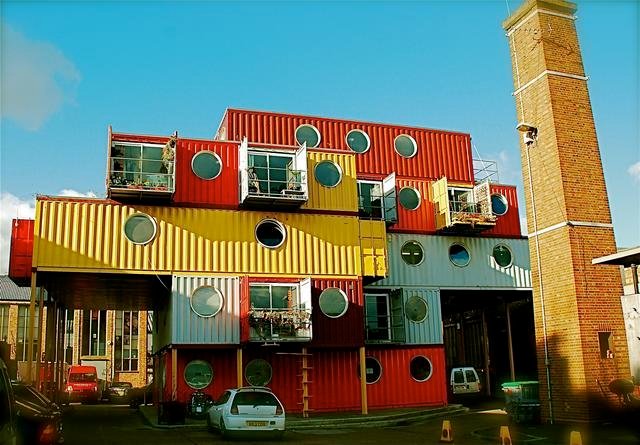In the world of growing pollution and increasingly hazardous greenhouse gases, thinking green is not enough – you have to act green too if you want to help save the planet. As the quantities of toxic waste keep increasing and innovative sustainable technologies are becoming a widespread trend, eco-friendly activism has become an obligation for any environmentally responsible individual and it’s no longer just an issue promoted by a handful of fervent wildlife protection advocates.
Eco-friendly technologies are gradually finding their way to all areas of life, from automotive and food industry to construction and architecture, and one of the recent trends that has been gaining popularity in the building sector fast in the past few years is the use of empty shipping containers to create habitable facilities for various purposes, from apartments, studios and offices to schools and emergency shelters.
The Origins of Cargo Container Architecture
Looking back at the history of architecture, the first examples of container-based facility designs can be found in late ‘80s, when Phillip C. Clark applied a patent in the U.S. based on a “method for converting one or more steel shipping containers into a habitable building.” The patent was granted two years later and listed under the number 4854094 and it has since become a cornerstone for a number of contemporary container-based architectural ideas and prefabricated housing designs.
Prominent Examples of Container-based Architecture
Californian architect Peter DeMaria designed the first ever two-level shipping container home in the U.S. and it was even nationally recognized as a structural system pursuant to the Uniform Building Code. Another example of shipping container-based architecture is found in the Puma City designed by New York/Napoli-based office LOT-EK: painted in red and white colorways with the brand’s recognizable animal logo, this brilliant sustainable edifice is used a three-level store with a bar/lounge area and two decks covering over 11,000 square feet. Rather affordable material-wise, easy to transport and simple to assemble, Puma City consists of 24 containers arranged together in a Lego-like fashion.

Reasons to Use Shipping Containers as Construction Material
And just why would anyone use cargo containers to build a home, office or temporary studio? Well, for starters, shipping containers are widely available, highly sustainable and relatively affordable (some containers can be purchased for as few as $900). The widespread availability of containers is due to their high return costs as most countries find it more cost-efficient to get new cargo container supplied than to ship back the existing ones, which are consequently frequently left lying around rotting at docks, landfills and outdoor warehouse grounds.
In other words, if you’re set on building yourself a home made from cargo containers, you can do that with no major hassle: shipping containers are relatively easy to find and it doesn’t take a considerable budget to bring one of your housing ideas to fruition. Plus, a container-based facility is extremely durable and can endure quite a bit of tough love from unfavorable elements and it is strong enough to stand up strong gusts of wind and a good portion of accidental bashes and hits.
Downsides of Container Homes and Similar Cargo Facilities
Despite their ruggedness and affordability, shipping containers have a few downsides you need to take into consideration before setting out to build your new all-metal house. First off, though eco-friendly in terms of reuse and recyclability, cargo containers used for ocean transport are treated with coatings containing hazardous chemicals like lead-based paints, phosphorous and chromate, and dangerous substances and pesticides like chromium and arsenic are also found in the wooden flooring.
That’s why repurposing containers requires some processing, as sandblasting, window and door cutting and floor removal, which combines with the quantity of fossil fuel needed for box transport to result in almost one thousand pounds of potentially harmful waste and a considerable environmental footprint. Also, thermal insulation of cargo containers additionally reduces their already limited dimensions, so your new container-made home may end up looking rather awkward and claustrophobic unless you decide to build a multi-box edifice instead of a single container.
The Final Say
In a world reigned by a growing need for housing and office space and fast-depleting renewable sources and sustainable construction materials, cargo containers can be a convenient option in architecture and design of purpose-built facilities. In areas with scarce building material resources or regions hit by natural disasters, container-based facilities can come in handy as a temporary shelter or emergency accommodation.
Despite their downsides, shipping containers are a sound option for innovative structure designs and they provide an expedient alternative to traditional building procedures and patterns. If you’re planning to make yourself a brand new prefabricated home but have no idea where to begin, try these clever metal blocks for size: affordable, widely available and simple to process and arrange, cargo containers may just be the best solution to all your green, housing-related woes.
Author Bio:Lillian Connors is green living enthusiast in charge of the sustainability segment on Smooth Decorator. You can check her out on Google+ , Twitter and LinkedIn.
The world is definitely moving towards a more eco-friendly and sustainable lifestyle. This article however is great as it points out the advantages of using a shipping container as a home but it also brings about the negatives of using containers for housing. One of the important facts you touched base on was the hazardous chemicals that may have been previously used on shipping containers whilst they’re at sea and I think it’s very important that readers are aware of this as it will assist them when purchasing a used shipping container. This article highlights some great key points and was a great read thank you for taking the time to write it.